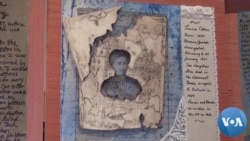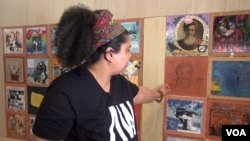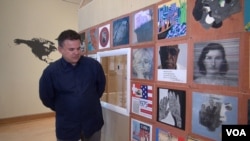Many different countries, voices and eras, but only one house.
Americans “find strength in diversity,” explains artist Ellyn Weiss, who co-organized the One House art exhibit outside of Washington D.C. The display demonstrates the richness and complexity of U.S. culture.
The exhibit, a large house structure at the BlackRock Center for the Arts, contains 300 panels, each representing a different ancestor. A few depict the country’s earliest inhabitants, American Indians, but the rest are immigrants, starting with some who arrived on the Mayflower in 1620.
“It goes through all of the major waves of immigration from Europe, from Asia, from South America, up to artists who arrived themselves from the Middle East about a year or two ago,” Weiss says.
The artists
For her panel, Shante Bullock chose her grandmother, who descended from American slaves and lived in North Carolina: “Even when we became free my grandfather still picked cotton.” But beyond that Bullock knows little about her family. “I have like the date when she was born and when she died, where we came from and that's my piece. I would love to know like some people here do, where (my) ancestors came from or the ship they come from… but it just stops. Even though we were brought here involuntarily, we also believe in hope and opportunity.”
Jamie Downs evoked his great-grandparents who came to the U.S. just before the Civil War: “They came here from Prussia on their honeymoon to north central Pennsylvania. They got some land, and he ran a fruit orchard and she taught Latin. Just hard to believe in very, very rural central Pennsylvania that there were people there to teach.”
Ric Garcia's parents came from Cuba when they were recently married to settle in New York: “It was as a result of a political revolution on the island… They were looking for opportunity, and they wanted to start a family, and they chose to come to this country that was offering asylum, and they came to the Port of Miami, and they were processed through a central building that used to be a Sears Tower.”
Kyujin Lee depicted her own departure from South Korea: “So to represent that I use the image of a pair of hands stitching or knitting from unraveled threads, and so unraveling represents the separation part of my journey to this country and a rethreading is sort of my reconnecting to adapting to a new land.”
The project
The One House Project is the work of a group of artists from the Washington DC region, who formed the group ArtWatch in January 2017, the same month that Donald Trump was sworn into office.
“We formed about two years ago to develop projects that use our visual arts skills to stand up for the values and the principles about America that are right: democracy, inclusion, unity, tolerance. And this is the largest project that we've done so far,” Weiss said.
Weiss dedicated her own panel to her grandfather, who fled religious persecution in Romania in 1900.
Abraham Miller was “into the wholesale [tableware] business. He bought a building in downtown Philadelphia,” Weiss said. “In those days, it was a pretty shabby part of town. Now it's a historical area building. It had two basements, one below the other, and it was a perfect place for him to store his stock and have easy access to it.”
Later, the Philadelphia Historical Society certified that the building was a stop on the Underground Railroad, used to help slaves escape from the south before the Civil War.
“I just thought that was such a beautiful story about how we are all intertwined in this country,” Weiss says.
To her, the One House Project is a testament to the continuing American dream.
“We represent a very wide swath of the world that's come to the U.S. fleeing persecution, seeking a better life, fleeing extreme poverty. And these are the elements that still drive migration today. It never has changed.”











